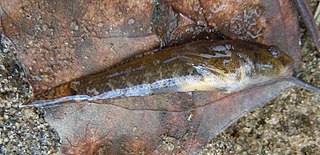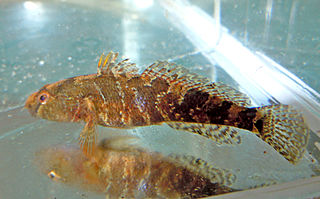
The round goby is a euryhaline bottom-dwelling species of fish of the family Gobiidae. It is native to Central Eurasia, including the Black Sea and the Caspian Sea. Round gobies have established large non-native populations in the Baltic Sea, several major Eurasian rivers, and the North American Great Lakes.

The slimy sculpin is a freshwater species of fish belonging to the family Cottidae, which is the largest sculpin family. They usually inhabit cold rocky streams or lakes across North America, ranging from the Great Lakes, southeast Minnesota, northeast Iowa, southwest Wisconsin and northeast Canada. Slimy sculpins have also been found roaming the cold streams of eastern Siberia. They are commonly confused with their closely related relatives, Mottled sculpin, and with tubenose gobies who are both freshwater fishes as well. The slimy sculpin is a nocturnal fish that usually spends most of its time on the stream bottom and seeks shelter under rocks and logs, especially during spawning season. When it swims, it sometimes appears to be "hopping" along the bottom because of its inefficient ability to swim. This is partly due to the absence of a swim bladder, which normally gives buoyancy to a fish.

The monkey goby is a species of goby native to the basins of the Black Sea and the Sea of Azov.

Neogobius is a genus of goby native to Black Sea and the Caspian Sea basins. It is part of the broader Benthophilinae subfamily which is also endemic to the same region. Nevertheless, two Neogobius species have recently turned out to be highly invasive and spread across Europe and even to the Great Lakes of North America.

The racer goby is a species of goby native to fresh, sometimes brackish, waters, of the Black Sea basin. It is a Ponto-Caspian relict species. The species is placed a monotypic genus, Babka, which was once considered a subgenus of genus Neogobius, but was then elevated to genus-status based on the molecular analysis.

Ponticola kessleri, the bighead goby or Kessler's goby, is a species of goby native to Eurasia. The bighead goby is a Ponto-Caspian relict species. It inhabits the fresh and oligohaline waters, with mineralisation from 0-0.5‰ up to 1.5-3.0‰.

Proterorhinus marmoratus is a species of gobiid fish, a tubenose goby native to the brackish water parts of the Black Sea and the Sea of Azov, near the coasts of Bulgaria, Georgia, Romania, Ukraine and Russia. Also it is found in the Marmora Sea (Turkey). It can reach a length of 11.5 centimetres (4.5 in) TL.

The Chornaya tubenose goby is a species of goby endemic to Crimea, Ukraine where it is only found in a short stretch of River Chornaya. Water is extracted in large quantities for irrigation could cause the stream to completely dry out in summer and thus poses a critical risk of extinction in a near future.

Proterorhinus semipellucidus is a species of gobiid fish, a tubenose goby originally described from the Gharasu River near Gorgan Bay of the Caspian Sea in Iran. Following the systematic decomposition of the tubenose gobies it was suggested to be a more widespread and invasive taxon distributed in the fresh waters of the Caspian Sea basin. It may be the same species as that known as Proterorhinus nasalis.

Proterorhinus is a genus of fishes, known as the tubenose gobies. These gobiid fish are native to Eurasia where they occur in the region of the Caspian and Black seas, inhabiting marine, brackish and fresh waters. The species Proterorhinus semilunaris was introduced to the St. Clair River in Michigan during the late 1990s. Until recently, the genus was considered monotypic, comprising only the tubenose goby. Following molecular and further morphological investigations it has been split into several taxa, with distinct distributions in marine vs. fresh waters and in the Black Sea vs. Caspian Sea basins.

The eastern tubenose goby is a species of gobiid fish native to fresh and brackish waters of the basins of the Sea of Azov and the Caspian Sea and has invaded the upper reaches of the Volga River from its native occurrence in the delta. This species prefers slow flowing rivers or still waters with plentiful rocks or vegetation. It can reach a length of 9 centimetres (3.5 in) SL. It is probably the same species as that recently treated as Proterorhinus semipellucidus.

The Benthophilinae are a subfamily of gobies endemic to the Ponto-Caspian region. The subfamily includes about 50 species. The representatives of the subfamily have fused pelvic fins and elongated dorsal and anal fins. They are distinguished from the closely related subfamily Gobiinae by the absence of a swimbladder in adults and location of the uppermost rays of the pectoral fins within the fin membrane.

True gobies were a subfamily, the Gobiinae, of the goby family Gobiidae, although the 5th edition of the Fishes of the World does not subdivide the Gobiidae into subfamilies. They are found in all oceans and a few rivers and lakes, but most live in warm waters. Altogether, the Gobiinae unite about 1149 described species in 160 genera, and new ones are still being discovered in numbers.
Neogobius pallasi, the Caspian sand goby or the Caspian monkey goby, is a species of fish native to fresh and brackish waters of the Caspian Sea basin including the Volga drainage up to the vicinity of Moscow. It has been introduced into the Aral basin. This species of goby can reach a length of 20 centimetres (7.9 in) SL. It is also important to local commercial fisheries.

The Don tadpole-goby is a species of goby widespread in the basin of the Sea of Azov, specifically in the lower Don River and Tsimlyansk Reservoir. This species is found in rivers, reservoirs and river mouths, but is not known to enter seas. It is introduced and invasive upstream the Volga River, e.g. the Kuibyshev Reservoir. This fish can reach a length of 6.6 centimetres (2.6 in) SL. Life span is about one year.
The fish fauna of the Neretva river basin in the western Balkans is representative of the Dinaric karst region and characterized by several endemic and endangered species.
Cardiocephaloides longicollis is a species of flukes. The life cycle of C. longicollis is asexual as well as complex. Its asexual stage resides in the body of whelks where it replicates many times, and eventually its eggs are dispersed in the water through feces. C.longicollis begin their early life as free swimming miracidia larvae in the water. They go on to infect snails, and a variety of fishes, usually second intermediate host, in the form of a cercariae. While C.longicollis has previously been recorded in 19 fish species, researchers have found 12 other species which are viable hosts for C.longicollis making for a grand total of 31 aquatic species. The final host for this parasite are the gulls that eat the infected fish in which the parasite has formed cysts in.
Papuligobius uniporus is a species of small goby in the subfamily Gobionellinae. It is also the type species of the genus Papuligobius.
Holostephanus cobitidis is a species of parasitic trematode in the family Cyathocotylidae.



















